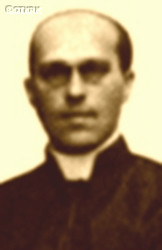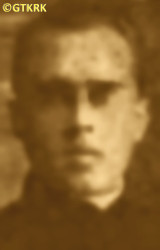Roman Catholic
St Sigismund parish
05-507 Słomczyn
85 Wiślana Str.
Konstancin deanery
Warsaw archdiocese, Poland
full list:
displayClick to display full list

searchClick to search full list by categories
wyświetlKliknij by wyświetlić pełną listę po polsku

szukajKliknij by przeszukać listę wg kategorii po polsku

Martyrology of the clergy — Poland
XX century (1914 – 1989)
personal data
surname
CAKUL
forename(s)
Michael (pl. Michał)
function
diocesan priest
creed
Latin (Roman Catholic) Church RCmore on
en.wikipedia.org
[access: 2014.09.21]
diocese / province
Mogilev archdiocesemore on
en.wikipedia.org
[access: 2013.06.23]
nationality
Latvian
date and place
of death
21.08.1937

Butovotoday: Vidnoye reg., Moscow oblast, Russia
more on
en.wikipedia.org
[access: 2020.07.31]
alt. dates and places
of death
1937
details of death
During World War I led efforts in 1914‐1917 to help Polish refugees in Symbirsk — founded „Polish Support Society for victims of war”.
For the first time arrested by the Russians on 26.03.1924 in Moscow.
Released after a weak on his own recognizance.
On 14.02.1927 arrested again and released after a few hours, again on his own recognizance.
Yet again arrested on 12.02.1929, accused of political crimes, but on 03.05.1929 again released.
Remained under constant supervision by Russian police.
For the fourth time arrested on 14.04.1931, in Moscow.
Accused of „pro‐Polish agitation and counter–revolutionary and anti–state activities”.
Prob. „broken” under interrogations.
In a mass trial of Catholics on 18.11.1931 in Moscow — tried with Fr Charles Łupinowicz and Anna Tyszman, among others — pursuant to Art. 58‐6, 58‐10 and 58‐11 of the Penal Code sentenced to 3 years of exile (including prison time in Moscow), but banned from settling in large cities.
Choose Tambor.
In 12.1933 released.
Last time arrested, together with church organ player and wife of the sacristan, on 03.05.1937 in Moscow, for celebrating a Mass on a National Day of Poland at the request of Polish ambassador in Moscow.
Jailed in Butyrki prison.
Prob. sentenced to 10 years of slave labour in Russian concentration camps — Gulag.
Before exile however sentenced again on 21.08.1937 to death for „spying” and on the same day murdered in unknown circumstances.
alt. details of death
According to some indications transported out of Moscow and murdered in one of the Gulag concentration camps.
cause of death
murder
perpetrators
Russians
sites and events
11.08.1937 Russian genocideClick to display the description, Great Purge 1937Click to display the description, ButovoClick to display the description, Forced exileClick to display the description, Trial of 18.11.1931Click to display the description, Moscow (Butyrki)Click to display the description
date and place
of birth
23.10.1885

Reveltoday: Tallinn, Harju cou., Estonia
more on
en.wikipedia.org
[access: 2021.12.18]
presbyter (holy orders)
ordination
1908

positions held
from c. 1919
administrator — Moscowtoday: Moscow city, Russia
more on
en.wikipedia.org
[access: 2020.07.31] ⋄ Immaculate Conception of the Blessed Virgin Mary RC parish ⋄ Moscowtoday: Moscow city, Russia
more on
en.wikipedia.org
[access: 2020.07.31] RC deanery
from 1933
administrator — Moscowtoday: Moscow city, Russia
more on
en.wikipedia.org
[access: 2020.07.31] ⋄ St Peter and St Paul the Apostles RC parish ⋄ Moscowtoday: Moscow city, Russia
more on
en.wikipedia.org
[access: 2020.07.31] RC deanery
c. 1925 – c. 1928
dean — Polotsktoday: Polotsk dist., Vitebsk reg., Belarus
more on
en.wikipedia.org
[access: 2023.01.18] RC deanery
c. 1925 – c. 1928
parish priest — Polotsktoday: Polotsk dist., Vitebsk reg., Belarus
more on
en.wikipedia.org
[access: 2023.01.18] ⋄ Blessed Virgin Mary of the Rosary RC parish ⋄ Polotsktoday: Polotsk dist., Vitebsk reg., Belarus
more on
en.wikipedia.org
[access: 2023.01.18] RC deanery
c. 1923
parish priest — Moscowtoday: Moscow city, Russia
more on
en.wikipedia.org
[access: 2020.07.31] ⋄ Immaculate Conception of the Blessed Virgin Mary RC parish ⋄ Moscowtoday: Moscow city, Russia
more on
en.wikipedia.org
[access: 2020.07.31] RC deanery
1912 – c. 1919
parish priest — Simbirsktoday: Ulyanovsk, Ulyanovsk oblast, Russia
more on
en.wikipedia.org
[access: 2022.02.15] ⋄ Exaltation of the Holy Cross RC parish — also: prefect at the Cadet Corps school, gymnasiums for boys and girls, trade school
1910 – 1912
curatus/rector/expositus — Rudnya‐Shlyaginatoday: Svetilovichi ssov., Vetka dist., Gomel reg., Belarus
more on
ru.wikipedia.org
[access: 2022.06.29] ⋄ Sacred Heart of Jesus RC chapel ⋄ Gomeltoday: Gomel dist., Gomel reg., Belarus
more on
en.wikipedia.org
[access: 2021.09.17], Assumption of the Blessed Virgin Mary RC parish ⋄ Gomeltoday: Gomel dist., Gomel reg., Belarus
more on
en.wikipedia.org
[access: 2021.09.17] RC deanery
1908 – 1910
vicar — Gomeltoday: Gomel dist., Gomel reg., Belarus
more on
en.wikipedia.org
[access: 2021.09.17] ⋄ Assumption of the Blessed Virgin Mary RC parish ⋄ Gomeltoday: Gomel dist., Gomel reg., Belarus
more on
en.wikipedia.org
[access: 2021.09.17] RC deanery
till 1908
student — Sankt Petersburgtoday: Saint Petersburg city, Russia
more on
en.wikipedia.org
[access: 2020.07.31] ⋄ philosophy and theology, Metropolitan Theological Seminary
others related
in death
ŁUPINOWICZClick to display biography Charles Alexander, TYSZMANClick to display biography Anne, KULHAWIECClick to display biography Simeon, NIKATOWClick to display biography Alex, SAWICKIClick to display biography Yaroslav, SIENKIEWICZClick to display biography Alex, MIEDWIEDIUKClick to display biography Vladimir
sites and events
descriptions
11.08.1937 Russian genocide: On 11.08.1937 Russian leader Stalin decided and NKVD head, Nicholas Jeżow, signed a «Polish operation» executive order no 00485. 139,835 Poles living in Russia were thus sentenced summarily to death. According to the records of the „Memorial” International Association for Historical, Educational, Charitable and Defense of Human Rights (Rus. Международное историко‐просветительское, правозащитное и благотворительное общество „Мемориал”), specialising with historical research and promoting knowledge about the victims of Russian repressions — 111,091 were murdered. 28,744 were sentenced to deportation to concentration camps in Gulag. Altogether however more than 100,000 Poles were deported, mainly to Kazakhstan, Siberia, Kharkov and Dniepropetrovsk. According to some historians, the number of victims should be multiplied by at least two, because not only the named persons were murdered, but entire Polish families (the mere suspicion of Polish nationality was sufficient). Taking into account the fact that the given number does not include the genocide in eastern Russia (Siberia), the number of victims may be as high as 500,000 Poles. (more on: en.wikipedia.orgClick to attempt to display webpage
[access: 2016.03.14])
Great Purge 1937: „Great Terror” (also «Great Purge», also called „Yezhovshchyna” after the name of the then head of the NKVD) — a Russian state action of political terror, planned and directed against millions of innocent victims — national minorities, wealthier peasants (kulaks), people considered opponents political, army officers, the greatest intensity of which took place from 09.1936 to 08.1938. It reached its peak starting in the summer of 1937, when Art. 58‐14 of the Penal Code about „counter‐revolutionary sabotage” was passed , which became the basis for the „legalization” of murders, and on 02.07.1937 when the highest authorities of Russia, under the leadership of Joseph Stalin, issued a decree on the initiation of action against the kulaks. Next a number of executive orders of the NKVD followed, including No. 00439 of 25.07.1937, starting the liquidation of 25,000‐42,000 Germans living in Russia (mainly the so‐called Volga Germans); No. 00447 of 30.07.1937, beginning the liquidation of „anti‐Russian elements”, and No. 00485[2] of 11.08.1937, ordering the murder of 139,835 people of Polish nationality (the latter was the largest operation of this type — encompassed 12.5% of all those murdered during the «Great Purge», while Poles constituted 0.4% of the population). In the summer of 1937 Polish Catholic priests held in Solovetsky Islands, Anzer Island and ITL BelbaltLag were locked in prison cells (some in Sankt Petersburg). Next in a few kangaroo, murderous Russian trials (on 09.10.1937, 25.11.1937, among others) run by so‐called «NKVD Troika» all were sentenced to death. They were subsequently executed by a single shot to the back of the head. The murders took place either in Sankt Petersburg prison or directly in places of mass murder, e.g. Sandarmokh or Levashov Wilderness, where their bodies were dumped into the ditches. Other priests were arrested in the places they still ministered in and next murdered in local NKVD headquarters (e.g. in Minsk in Belarus), after equally genocidal trials run by aforementioned «NKVD Troika» kangaroo courts.
Butovo: Russian genocidal NKVD shooting range n. Moscov. From 08.08.1937 place of mass executions (during Great Purge). Till 19.10.1938 there were murdered 20,765 people (95.86% men), including 1,176 Poles — according to fragmentary available data. Among the executed were 739 Russian Orthodox priests, including 7 bishops and Metropolitan bishops with 81 years old Metropolitan bishop Seraphim Chichagov, today the saint of Orthodox church (this church canonised 255 of the victims), and Lutheran and Protestant pastors and Catholic priests, mainly from Poland and Austria. Place known today and „Russian Golgotha”. (more on: en.wikipedia.orgClick to attempt to display webpage
[access: 2020.07.31])
Forced exile: One of the standard Russian forms of repression. The prisoners were usually taken to a small village in the middle of nowhere — somewhere in Siberia, in far north or far east — dropped out of the train carriage or a cart, left out without means of subsistence or place to live. (more on: en.wikipedia.orgClick to attempt to display webpage
[access: 2014.12.20])
Trial of 18.11.1931: Trial against Catholic church members held in Moscow on 18.11.1931. They were accused of „Polish nationalism and religious fanaticism, illegal contacts with Polish and Lithuanian foreign missions in Russia, contacts with Polish spies and support of their activities, anti‐Russians activities, counter‐revolutionary agitation”, among others. Most were exiled, mainly to Kazakhstan.
Moscow (Butyrki): Harsh transit and interrogation prison in Moscow — for political prisoners — where Russians held and murdered thousands of Poles. Founded prob. in XVII century. In XIX century many Polish insurgents (Polish uprisings of 1831 and 1863) were held there. During Communist regime a place of internment for political prisoners prior to a transfer to Russian slave labour complex Gulag. During the Great Purge c. 20,000 inmates were held there at any time (c. 170 in every cell). Thousands were murdered. (more on: en.wikipedia.orgClick to attempt to display webpage
[access: 2020.05.01])
sources
personal:
www.ofiaryterroru.plClick to attempt to display webpage
[access: 2019.02.02], biographies.library.nd.eduClick to attempt to display webpage
[access: 2014.12.20], pl.wikipedia.orgClick to attempt to display webpage
[access: 2019.02.02], bazhum.muzhp.plClick to attempt to display webpage
[access: 2019.02.02]
bibliographical:
„Fate of the Catholic clergy in USSR 1917‐1939. Martyrology”, Roman Dzwonkowski, SAC, ed. Science Society KUL, 2003, Lublin
original images:
www.russiacristiana.orgClick to attempt to display webpage
[access: 2021.12.19], 100lattemu.plClick to attempt to display webpage
[access: 2019.02.02], ipn.gov.plClick to attempt to display webpage
[access: 2019.02.02]
LETTER to CUSTODIAN/ADMINISTRATOR
If you have an Email client on your communicator/computer — such as Mozilla Thunderbird, Windows Mail or Microsoft Outlook, described at WikipediaPatrz:
en.wikipedia.org, among others — try the link below, please:
LETTER to CUSTODIAN/ADMINISTRATORClick and try to call your own Email client
If however you do not run such a client or the above link is not active please send an email to the Custodian/Administrator using your account — in your customary email/correspondence engine — at the following address:

giving the following as the subject:
MARTYROLOGY: CAKUL Michael
To return to the biography press below:
 Click to return to biography
Click to return to biography










